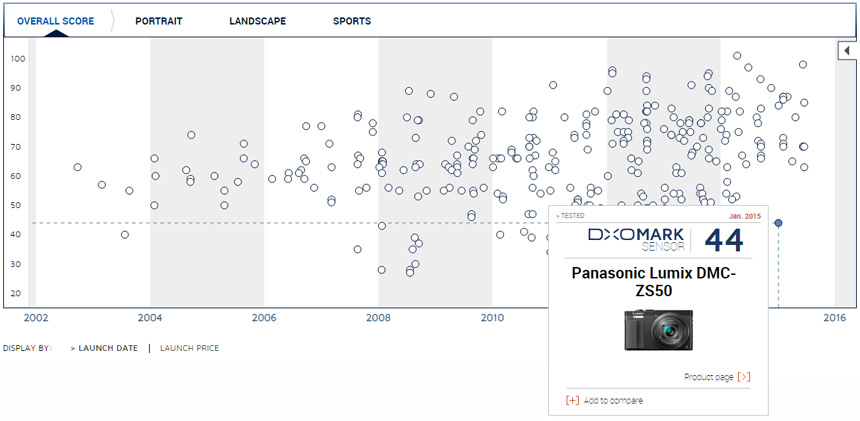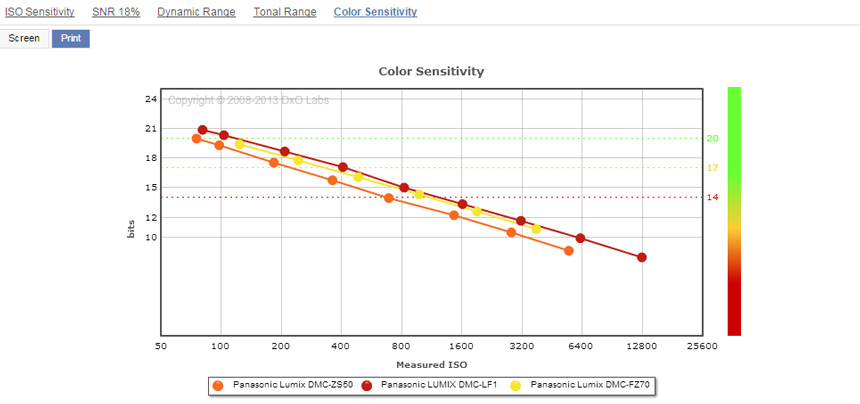Introduction
The Panasonic Lumix DMC ZS50 (known as the TZ70 in Europe) is a compact-sized camera with a large (30x) zoom range equivalent to a 24-720mm, complete with 5-axis image stabilization and a 12.1-Mpix 1/2.3-inch MOS sensor (down from the 18-Mpix of its DMC-ZS40 predecessor). The rangefinder-style camera also has a high-res 1.2M-dot electronic viewfinder, full manual controls (including a programmable control ring surrounding the lens), a built -n flash, and a fixed 3.0” 1.04M dot LCD to the rear. The ring surrounding the lens offers control over a number of features, including focal length, exposure, and focus.
Besides the option for RAW capture in stills, which is unusual enough in compacts, the ZS50 also has a number useful of features aimed at video enthusiasts. This includes focus peaking, a feature that will also appeal to still photographers, and a 50/60p Full HD 1920×180 option in addition to the usual 25/30p regional choices. Like other recent models from the firm, the Lumix DMC-ZS50 has integrated WiFI connectivity with NFC (or QR code as an option) for remote control and sharing images via a smartphone or tablet.
The Panasonic Lumix DMC-ZS50 measures 4.4 x 2.5 x 1.4” / 110.6 x 64.3 x 34.4mm and weighs 8.57 oz (243g). It is available now at $397.99 (USD).
- 12.1-Mpix 1/2.3-inch MOS sensor
- 24-720mm equivalent Leica DC Vario-Elmar lens
- Shake reduction
- Venus Engine image processor with ISO 6400 max
- Continuous shooting up to 10 fps (JPEG).
- 1.2m-dot EVF
- 3.0-inch 1.04m-dot LCD
- Full HD 1080p video at 60/30 fps
- Built-in WiFi with NFC
Measurements: Good, but behind best-in-class
Achieving an overall DxOMark sensor score of 44 points, the Lumix DMC-ZS50 achieves a good score for a 1/2.3-inch type sensor, although it is only an incremental increase in performance over similar-sized sensors used in earlier models from the company. Adopting a DSLR-style body and layout, the 16-Mpix Panasonic Lumix DMC-FZ70 (for instance) achieved a DxOMark score of 41 points, and with the same 12.1-Mpix count as the ZS50, the DMC-FZ200 from 2012 managed just 37 points. Nevertheless, the 12-Mpix Pentax Q and Q10 (also from 2012) secured higher DxOMark sensor scores of 47 and 49 points, respectively, and the 12-Mpix Canon PowerShot SX50, also from the same period, achieved 47 points.
Comparison: Panasonic Lumix DMC-ZS50 vs. Panasonic Lumix DMC-LF1 vs Panasonic Lumix DMC-FZ70: Competitive dynamics
Despite the age advantage when compared with the slightly larger 1/1.7-inch type sensor found in the Lumix DMC-LF1 (a similar rangefinder-styled model from 2013 with an EVF and 12-1-Mpix back-illuminated CMOS sensor, and a 28-200mm equivalent f2.0-5.9 zoom), the ZS50 is still somewhat behind in sensor dynamics. It has lower color sensitivity, a not-so-forgiving dynamic range, and almost a stop lower low-light ISO.
Against the 16-Mpix Lumix DMC-FZ70 from around the same period, but adopting the same-sized 1/2.3-in type senso,r we can see that there’s not much to be gained from adopting a lower pixel count. With slightly lower noise levels, the ZS50 has an +0.6 bit advantage in color sensitivity and a slightly wider dynamic range of +0.4Ev at base, but it loses out to the FZ70 on low-light ISO by around –0.3Ev.
Conclusion
With exciting specs, including a Leica branded 24-720mm zoom and 5-axis stabilization squeezed into a compact rangefinder-style body complete with an EVF, the Lumix DMC-ZS50 looks tempting enough. Panasonic’s decision to return to a lower 12-Mpix sensor in the DMC-ZS50 to improve noise levels and low-light performance, however, doesn’t appear entirely justified (although we’ve yet to test its predecessor, the 18-Mpix DMC-ZS40). It’s not a bad performer under most situations, but low-light performance isn’t one of its strong points.








DXOMARK encourages its readers to share comments on the articles. To read or post comments, Disqus cookies are required. Change your Cookies Preferences and read more about our Comment Policy.